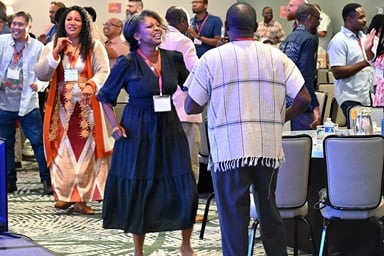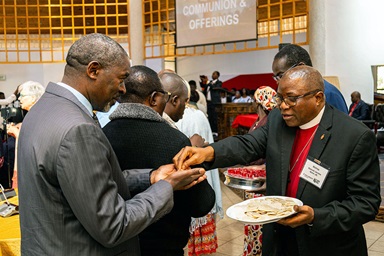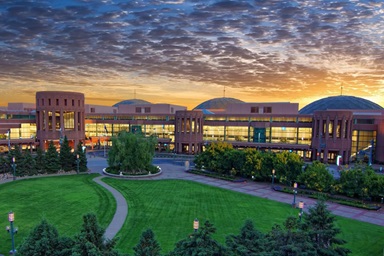The horses at the far end of the pasture pick up their ears and look in the direction of the gate. As they watch, four people approach, talking softly among themselves. The horses shake their manes and begin picking their way toward the group; they are quite familiar with the exercises they will be participating in today.
But for The Rev. Doug Hodson, pastor of Glendora United Methodist Church in Glendora, Calif., and his wife, Kris, director of congregational loans for the California-Pacific Annual (regional) Conference, this is definitely a new experience.
“I had some trepidation doing it,” says Kris. “But when you stand out in a very open area and these animals just simply come up to you and you’re in the moment and you let go of the fear, you begin to develop this sense that they can communicate with us in ways we don’t understand.”
The workshop the Hodsons are attending, Equine-Facilitated Learning, is not classified as therapy, but its results have been called therapeutic. Facilitator Vickie Cottle has led Equine- Facilitated Learning sessions at her ranch in Descanso, near San Diego, for several years.
Working with those wrestling with drug addiction, searching for direction, or coping with grief and even terminal illness, she has many times seen “spiritual or emotional healing.” Being with horses, she says, helps people be with themselves, and that, in turn, helps them find the answers and strength that lie within. “Basically, I want people to be able to have an experience of focusing in the present, in the here and now, because that’s what has allowed horses to stay on the planet for such a long time.”
So, what can a pastor learn from a horse? Quite a bit, according to the Rev. Robert Wagener, a retired pastor. Wagener has attended several workshops with Cottle and has seen firsthand the benefits of Equine-Facilitated Therapy. It was his idea to ask Cottle to structure a session specifically for pastors and he is excited about the possibilities. For Wagener, working with horses “teaches you to be in connection with your people. And if you’re truly connected with them, they’ll follow you.”
Taking the lead
In fact, getting a horse to “follow” was one of the more enlightening activities of the day. As Cottle unlatches the gate, one horse, a large black stallion with a white blaze down his face, comes forward to meet the guests. Shadow is the horse Cottle has chosen to work with today — or, as she says, “he chose us.”
Cottle trained with author and facilitator Linda Kohanov, writer of “The Tao of Equus” and “The Power of the Herd," and founder of Eponaquest, educational workshops that employ horses for personal development and learning. She uses several different “horse exercises” when leading workshops, but today the group will focus on “Embodying the Goal.”
Working in the round pen, Shadow will walk, trot or gallop, around the perimeter guided by the commands of the person directing him. That is where the idea of leadership and communication comes into sharp focus. “A horse is a very obedient animal,” says Doug Hodson. “But as obedient as the horse was, at first I had a hard time getting it to do what I wanted it to do. I kept letting it go where it wanted to go.”
One by one, the three participants guide Shadow with a stick, which functions as an extension of the arm. They never actually touch the horse with the stick. They must indicate to the horse through gestures, body language and intention to move forward, pick up speed or stop. For Doug Hodson, the exercise was enlightening. “My take-away was, if, as a pastor, you’re unsure where you want your people to go —— they’re a little bit like a horse. They won’t know where to go.”
According to Kris Hodson, the individual experiences mirrored the unique personalities of the participants. “In my case, the horse would start going around and then suddenly stop. Sometimes it was the way I had placed my body. Sometimes it was the placement of the stick. Sometimes Vickie would say, ‘Your energy has just stopped.’” As a project coordinator, Kris says that although she gives clear and articulate directions when assigning a task, she now realizes she may be “dropping her energy” or not following up well with those carrying out the directions.
Robert Wagener had reservations the first time he worked with Shadow because of the horse’s size. Today he found the “humbling aspect” of having a “thousand-plus-pound being” follow his commands to be a profound metaphor for leading a congregation. Watching horses at Vickie’s ranch and near his own home, he has seen how the lead horse guides rather than dominates the herd, and, for Wagener, that concept applies to pastors. “I am your leader and I want you to follow me. And as you follow me I want you to trust me that I would never harm or hurt you.”
Learning to listen
The concept of non-verbal communication became another focal point of the day’s activities and discussions afterward. According to Cottle, horses have a strong sense of what a person is feeling compared with what the person is saying. She calls it being emotionally congruent. “In other words, their insides and their outsides are the same.”
As an example, if a person is an addict and pretending to be in control, the horses will avoid them and consider them dangerous to the herd. On the other hand, if a person is honest about feeling upset, the horses will focus on that person, pointing their ears forward and often moving near as if to protect.
Because counseling is such an important part of a pastors’ vocation, learning to key in to the non-verbal cues a client may be giving — and that they may be giving to a client — is extremely beneficial. Cottle says Kohanov’s book says experts believe 90 percent of communication is non-verbal. “Am I standing up straight or am I slumped? Are the knees locked or are they relaxed? Is the person holding their breath? If a person’s holding their breath the horses will look around like, ‘Is there something we should be scared of?’”
Horses, as animals of prey, have learned to survive by using these powers of observation and as Doug Hodson says, “being very intuitive.” “They have a way of communicating with each other in the herd that is even true in domesticated horses.” Wagener, who brought the scriptural passage of the lion and the lamb to share at the beginning of the day, asks the group how one’s communication style might impact another person’s sense of trust. For Doug Hodson, it’s pretty clear that a predatory leadership style is not going to work well with horses – but it’s “probably not going to work well with people either.”
In between formal learning sessions, the three guests spend time just being with the horses and interacting with them. For Kris Hodson, it underscores the idea that good communication involves taking enough time to listen. “My ‘take-away’ is that I jump to creating solutions too quickly. Let’s say I’m conversing with a pastor and they’re feeling overwhelmed with a situation. Let’s just be in that moment. And then when the time is right, let’s allow God to lead us into focusing on solution.”
“My sense of Jesus was that he had a connection with people; that if he was talking to you, he was talking to just you,” says Cottle. In her observation, working with horses helps people make a connection with themselves that they may have lost and that in turn can increase their ability to connect with and have compassion for others.
Awe
As the day comes to a close, the horses are led back to the pasture and the four people gather to reflect on an experience that they admit can’t be fully put into words. “Of the three of us,” Kris Hodson says, “I am probably the least competent around horses. But there was nothing to be concerned about. Only my own vulnerability. And that’s part of what you’re facing. You’re facing your own vulnerability.”
For Wagener, who has faced physical threat and emotional anger as a pastor, it was “an extraordinary opportunity to learn about danger and how to manage that and how to assess it so that we didn’t put ourselves in harm’s way. That’s self-care.”
Although horses are not aggressive by nature and the horses that Cottle work with are very gentle, a horse could hurt you unintentionally simply because of its size. So, there is an element of faith for Doug Hodson that is not only about being able to trust the horse, “it’s about being able to trust yourself.”
“It can be compared to our approach to God. The Hebrew word can sometimes be translated as 'fear' and sometimes as 'awe,' and you very much have that experience with these horses because they are huge.”
For the Hodsons, it is an experience they expect to “process,” as Kris puts it, for a long time. “It’s hard to put it into words,” she explains, “and I’m still having insights about what I learned. But it was definitely spiritual.”
“You bond with these horses,” observes Doug, “and you become, I can’t explain it in any other way, a part of their herd. That’s a hugely, deeply theological thing, to be a part of the family, a part of the group. It’s almost a kind of an embodiment of God’s grace.”
As to the impact of the day? “Good Lord,” he laughs. “It happened on Friday. On Sunday it showed up in the sermon!”
The next Equine-Facilitated Learning workshop for clergy is scheduled for February 28, 2014 in Descanso, California. For more information, contact Vickie Cottle at [email protected] or Robert Wagener at [email protected]
Published Feb. 19, 2014.
Like what you're reading? Support the ministry of UM News! Your support ensures the latest denominational news, dynamic stories and informative articles will continue to connect our global community. Make a tax-deductible donation at ResourceUMC.org/GiveUMCom.








